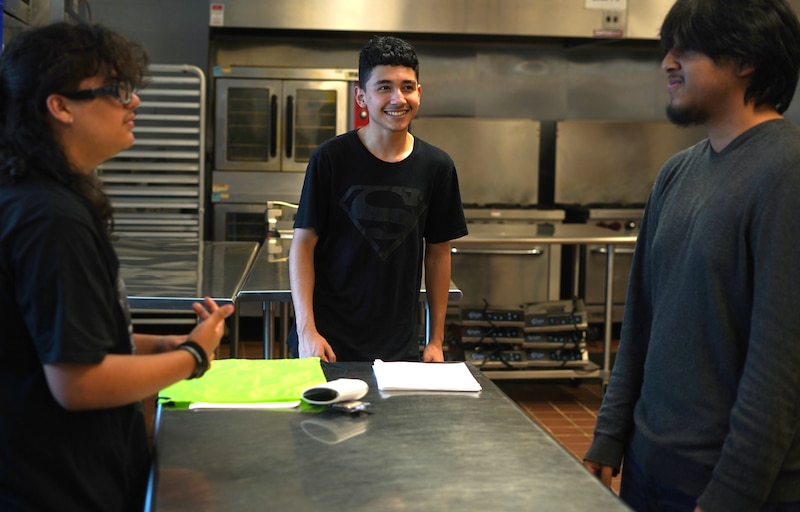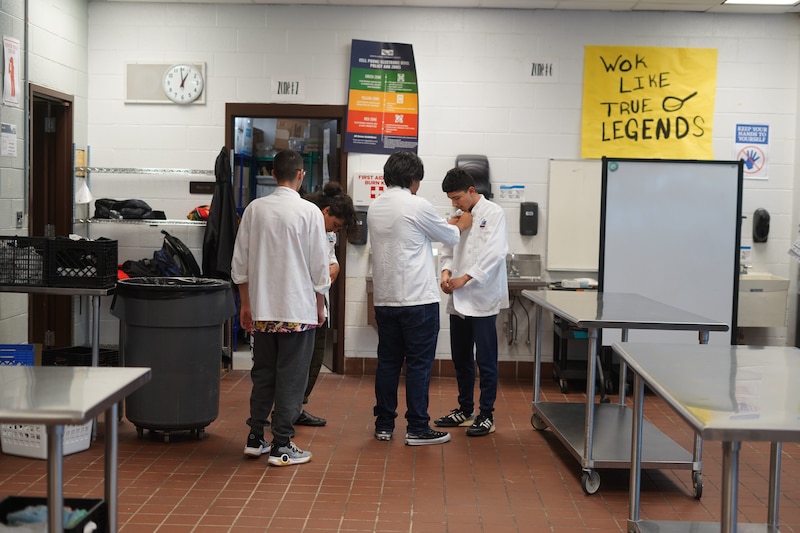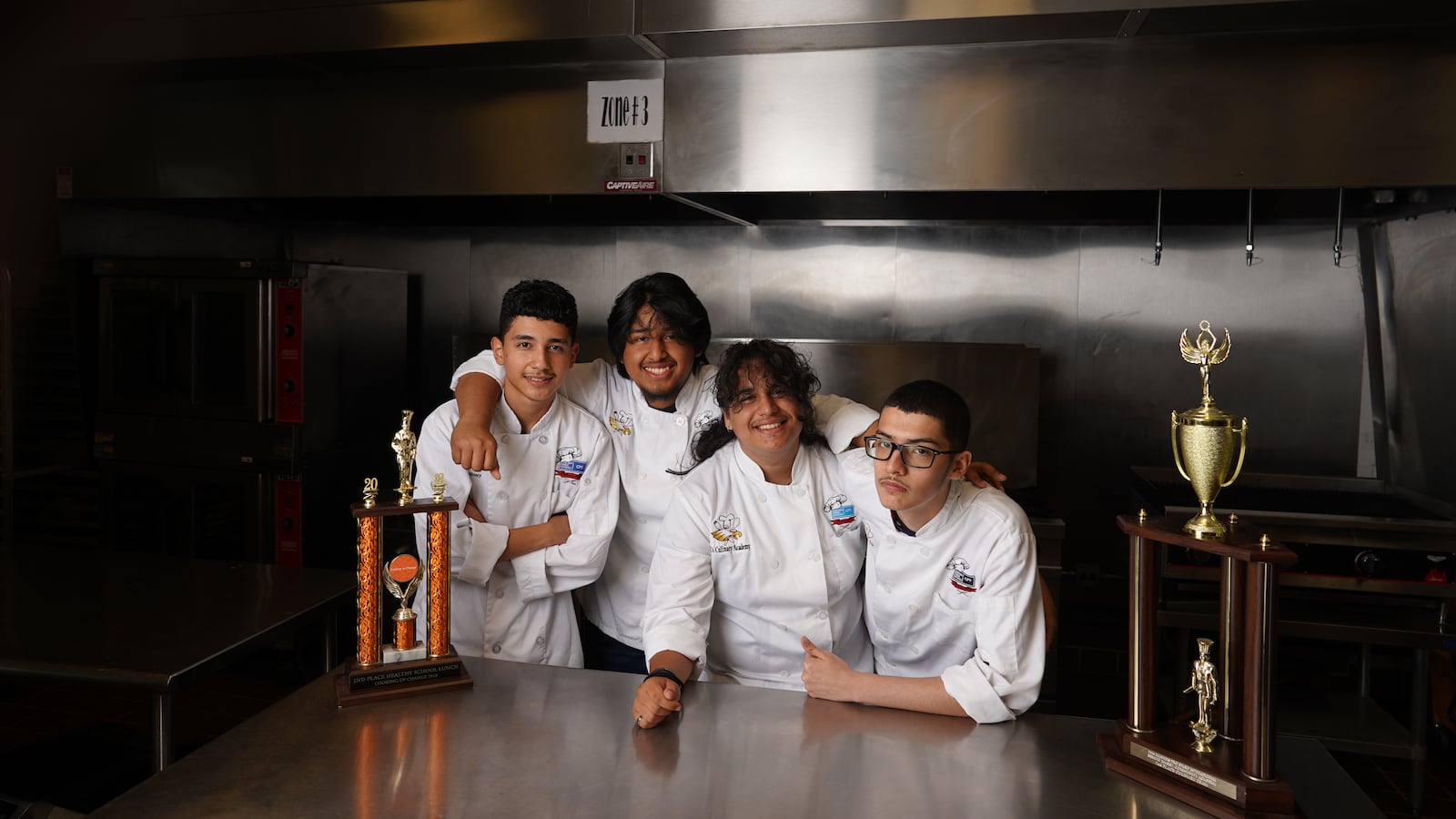When Chef Samantha Jones arrived at Juarez High School in Chicago six years ago, she discovered a shell of a culinary program.
Jones set about to change that: She created a curriculum, arranged regular produce deliveries, and sought out opportunities for students to show off their skills outside the school’s kitchen. When the pandemic shuttered the school building, she crisscrossed the predominantly Latino neighborhoods on the city’s Southwest Side to drop off ingredient kits at students’ homes.
More recently, Jones has taken students to meet chefs at the premiere James Beard Restaurant and Chef Awards downtown, shuttled them to contests where some earned thousands of dollars in culinary school scholarships, and planned a trip to Italy next year to visit a mozzarella maker and olive tree farm.
“Those hands-on opportunities have created buzz for our program,” Jones said. “In terms of students who actively want to be here — that’s changed dramatically.”
The resurgence of the culinary program at Juarez coincides with a rising profile of high school career and technical education, or CTE, in Chicago and nationally. Chicago Public Schools and other large urban districts are setting out to rethink and expand these programs in the wake of the pandemic as students look for more direct, debt-free routes to in-demand careers.
The push represents a shift away from the district’s recent emphasis on encouraging all students to go to college, which led to greater college enrollment but not necessarily a diploma. More than two-thirds of the district’s students still either don’t go to college or don’t finish it. An estimated 50,000 Chicagoans in their teens or early 20s — most of them Black and Latino high school graduates — are not in the workforce or in school, even as local employers clamor for workers.
Now the hope is that more robust CTE programs can send off more teens with a clear post-high school path as the district is vowing to focus on better serving Black and Latino boys.
But for districts such as Chicago, shifting gears on CTE can be a heavy lift. Chicago has CTE powerhouse schools such as Juarez, with strong programs rich in hands-on opportunities — and CTE deserts, neighborhoods with few offerings or programs that don’t do as much to help students jump-start their lives after high school.
Data on student outcomes is spotty, but numbers obtained by Chalkbeat suggest a relatively small portion of the district’s roughly 15,000 CTE students — who are disproportionately Black — get the work experience, college credit, and credentials considered the gold standard for high school career programs.
Pedro Martinez, a national champion of CTE who took over Chicago Public Schools last fall, says he wants students graduating from the district’s programs ready to tackle training programs or college — or to start building careers, perhaps returning to school later to gain more skills. He’d like to see more students graduating with work experiences, industry certificates, and college credit, even associate degrees.
“This is where I see education going in the future,” said Martinez, the former superintendent of the San Antonio Independent School District. “I see a convergence of pre-K-12, higher education, and industry all coming together.”

CTE held a lower profile amid college push
Janice Jackson, who stepped down as Chicago Public Schools CEO last year, had focused on building a college-going culture in the district.
Several CTE programs – some underenrolled and outdated – closed during Jackson’s tenure. But Jackson said in an interview with Chalkbeat after she left the district that she came to better appreciate career education’s value.
“We went from not having a college-going culture almost to the extreme, where that’s all we talked about,” she said. “What we learned is the same skills that students need to successfully complete high school, they need to access trade programs.”
Those program closures and a relatively low profile for CTE over the past decade have left the district with uneven offerings. Last year, as the district mulled an expansion of citywide programs, it studied which career fields merited additional programs because of high employer demand and competitive pay — and which parts of the city could most use those programs.
The analysis, obtained by Chalkbeat, zeroed in on business, construction, IT, and the health sciences, and found students in large swaths of the city don’t have access to those types of programs. Programming is particularly thin on the city’s West and Near West sides and in areas such as the Southwest Side’s Greater Stockyards — parts of the city that are predominantly Latino and Black. The more diverse Northwest Side generally offers robust access to a variety of programs.
“We’ve got some stellar programs, and some of our kids are doing amazing stuff,” said Sarah Rothschild, a Chicago Teachers Union education policy researcher who serves on the union’s CTE committee. “But there’s no consistency and stability across schools. Some of the kids who can benefit the most in disinvested communities have the least access.”
Overall, roughly 14% of the district’s high school population is enrolled in CTE programs — a portion that has remained relatively stable since 2016. Black students, who make up about 36% of Chicago’s student body, account for 45% of CTE enrollment.
During contract negotiations in 2019, the teachers union pushed for more central office oversight of CTE programs. It argued that principals on the South and West sides confronting shrinking enrollment, slimmer budgets, and pressure to show improved college enrollment metrics were shuttering programs. That left some schools as “career academies” in name only, with one or two remaining programs. District officials now sign off on closures after consulting with the union and local school councils.
Chicago has little data on its CTE programs
The hands-on opportunities CTE programs offer kept students such as Jerry Green engaged in school through the pandemic’s turbulence.
One Friday in May, Green, dressed in a white chef’s coat over black jeans, bustled at a hot plate, ladling chicken and vegetables into toasted pitas. Green and a couple of classmates in Clemente’s culinary arts program were facing off against teams from three other Chicago high schools in the district’s inaugural “Food Truck Wars” in May, with culinary school scholarships going to the winners.
Green, 18, watched anxiously as the judges tasted the team’s chicken gyros from an imaginary food truck named “Stuff It.” The Clemente students had conceived the trucks’ design, business plan, and menu.
Although the “Stuff It” team didn’t win the contest, the culinary arts program had already hooked Green up with a culinary certification, a scholarship to a local community college, and a summer job at a nonprofit that prepares meals for the homeless with leftover restaurant ingredients.
A growing body of research is showing some CTE models pay off, especially for low-income students and boys of color like Green.
As the national “college for all” movement wanes, a number of other factors have also given these programs a boost in recent years: more federal funding and requirements after the pre-pandemic passage of the Perkins V law; employers eager to build diverse talent pipelines amid crippling worker shortages; and students wanting more direct access to well-paying careers in high-growth fields.
New York City, where Mayor Eric Adams and schools Chancellor David Banks have recently held up CTE as key to reengaging students, crafted a five-year strategic plan for CTE last year. The city is the birthplace of the P-TECH high school model, which has shown promising gains in graduation and earning potential. In these schools, students cultivate both academic and workplace skills with the goal of graduating with industry-recognized associate degrees.
More recently, Dallas has bet big on the P-TECH model. Martinez recently traveled to Dallas with Juan Salgado, the chancellor of City Colleges of Chicago, to learn more about how that school district works with local community colleges and employers.
During the coming school year, Philadelphia, where district leaders tout a markedly higher than average graduation rate for its 6,000 CTE students, will review all 43 CTE programs to ensure they are attuned to employer needs and student demand.
The district also joined a partnership between Pennsylvania districts and the local maritime and defense industries that has connected students with apprenticeships and jobs. The efforts reflect a break with the idea of CTE as a dumping ground for students who struggle academically.
“It was always viewed as a program for those who ‘can’t, won’t, and don’t’ — for those not going to college,” said Michelle Armstrong, Philadelphia’s executive director of CTE. “We view CTE as giving our young people options.”
But experts say significant hurdles stand in the way of improving high school CTE programs, from a dearth of qualified educators to difficulties forging partnerships with employers and community colleges, to the lingering perception of CTE as a fallback for struggling students.
A shortage of data on student outcomes can also hamper overhaul efforts in districts that have faced relatively little pressure to compile numbers from their states or the federal government, says Shaun Dougherty, an expert on CTE at Vanderbilt University.
In response to Freedom of Information Act requests, Chicago officials said they don’t have data on how many CTE students graduate, go on to college, or land a job. The district doesn’t even comprehensively track the number of students who apply to these programs.
A recent brochure for families promoting the district’s CTE programs touts opportunities to participate in work-based learning, such as internships, to get industry certifications and to earn college credit. But solid data on the portion of students who actually participate in these opportunities is also hard to come by.
District data on certifications shows the portion of CTE students earning these credentials dipped before COVID hit, to about 12% in 2019, and dropped further during the pandemic, though the district said it saw an uptick this year.
District data also show significant gaps among campuses in the portion of students who engage in work-based learning and earn college credit. Unlike the vocational or shop programs of the past, today’s CTE programs are not only expected to prepare students for careers but also to tie into college-level programs for teens who want the option of getting additional training and credentials.
CPS leaders say they will track these numbers more closely as they set out to strengthen CTE offerings.
Martinez wants to work closely with colleges and employers
Even before Martinez took over the district last September, CPS officials were starting to explore ways to update the career programs.
Under Jackson, the district signed an agreement – called Chicago Roadmap – with the City Colleges of Chicago. The pact promises better coordination and a shared commitment to ensure students arrive on college campuses with clear career goals, which increases their odds of getting a diploma. One early example is a health sciences model pathway, with the district piloting two more— in manufacturing and IT — in the fall.
In a plan submitted to the state this spring, the district vowed to expand CTE with measurable goals. By 2025, for instance, each CTE student is supposed to participate in at least one work-based learning experience, and the district is adding staff this school year to coordinate these opportunities.
Martinez has signaled that CTE will loom large in a three-year blueprint for the district he is slated to unveil in the fall.
Martinez told Chalkbeat he believes more district high schools should embrace the P-TECH model. He said he wants to enlist large employers in the CTE push, mentioning recent conversations with Accenture and Amazon.
“The goal is to bring internships and job shadowing opportunities, especially for younger children — even exposure at the middle school grades,” Martinez said. “I’m telling industry partners, ‘You get to shape your workforce while they’re still in high school.’”

In the meantime, Jones, the culinary teacher at Chicago’s Juarez High School, is forging ahead. For the coming school year, the culinary program has a waitlist; students who did not get in are filling up the after-school cooking program.
“I didn’t realize culinary arts was this popular,” said Jah Pagan, who will be a junior this year.
Pagan said he feels lucky to be enrolled. He is already eyeing higher-stakes cooking competitions and summer jobs.
This spring, Pagan and his classmates squared off in a clash between two imaginary restaurants for their class capstone project. They hustled to finish sumptuous brunch spreads: French toast, yogurt parfaits, biscuits, sausage-and-fruit breakfast skewers and more.
In a corner, atop one of the industrial freezers, cooking competition trophies towered — a reminder of the program’s goal to jump-start students’ careers.
Mila Koumpilova is Chalkbeat Chicago’s senior reporter covering Chicago Public Schools. Contact Mila at mkoumpilova@chalkbeat.org.


